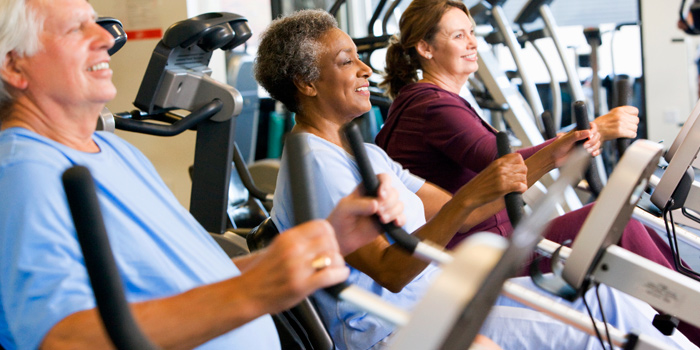Promoting Dialysis Patient Exercise: Just Do It (to Avoid Losing It)

It's hard to believe that some people—patients and professionals—still think dialysis patients should not exercise. I don't know how they could believe that when research has shown repeatedly that if dialysis patients aren't physically active, their physical functioning declines. When physical functioning declines, patients can no longer do things they need and want do. When they can no longer do things they need and want to do, they become more dependent. As they become more dependent, they become depressed. Depressed patients are less likely to take care of themselves, which puts them at higher risk of complications, hospitalizations, and death. This decline does not have to happen. Physical activity can improve quality of life, functioning and break the cycle of deconditioning—but it takes willingness on everyone's part to do more.
In survey research, several factors were identified as influencing whether dialysis staff encourage exercise: a job requiring professional training, a perception that patients were unmotivated and staff didn't have the skills to motivate them, and a belief that promoting exercise was not in their job description. One key ingredient in promoting exercise for dialysis patients is to have an exercise "cheerleader." This is true whether a patient is on in-center or home dialysis. The exercise cheerleader can be a home training nurse or any other dialysis staff member, a family member or friend.
Exercise equipment comes in a range of prices and some is more effective than others. Research has shown that exercise performed during dialysis can improve blood pressure, strength, endurance, and can even remove toxins easier which may help more patients achieve higher adequacy levels. This could result in improved Quality Improvement Performance (QIP) scores. Higher QIP scores helps a facility receive higher Medicare payment.
I've heard that patients who regularly complain of cramps or symptoms of restless leg syndrome during dialysis have stopped reporting these symptoms when biking on dialysis. Using a small peddler during dialysis may help relieve these uncomfortable symptoms while doing home or in-center treatments. When using hand weights, needles can be taped securely to reduce the risk of needle dislodgement or alarms, or a patient can exercise the non-dialysis arm only during treatment. Tracking time and distance biked and rewarding small successes can help maintain motivation. Home training nurses can help promote physical activity and keep patients motivated by asking what they're doing for activity level at each visit and monitoring their functioning with simple tests like timed walk and sit-to-stand-to-sit tests. Social workers can monitor changes in physical and mental functioning using the KDQOL-36 survey.
How can you get started helping patients to be more active? Type "exercise during dialysis" into Google, and you'll find links to articles and more. For example, search for "exercise in dialysis UVA" and you will find lots of information about a program at the dialysis clinic affiliated with the University of Virginia, like this article:
http://www.healthsystem.virginia.edu/pub/renal-services/exercise/nni-article.pdf
Here's a page with UVA research. The left frame has a link to info about equipment:
http://www.healthsystem.virginia.edu/pub/renal-services/exercise/research.html
Life Options has 3 booklets about exercise: a booklet for patients, one for nephrologists, and a prescribing guide to help dialysis clinics start an exercise program and/or help patients start exercising on their own (with their physician's approval). You might also want to look at the chapter on exercise in the Practical Guide to Renal Rehabilitation.
Many dialysis patients have cardiovascular disease (CVD), which is the most common cause of death in dialysis patients. Most people who have had heart attacks are encouraged to participate in cardiac rehab programs rather than avoiding exercise. We need to encourage our dialysis patients—who are at risk for cardiovascular disease—to ask their nephrologist and cardiologist to review and approve an exercise program. Promoting safe exercise may help us improve our patients' physical and mental functioning, and we could save lives by helping patients dialyze to live rather than living to dialyze.
References
- Giannaki CD, Stefanidis I, Karatzaferi C, Liakos N, Roka V, Ntente I, Sakkas GK. The effect of prolonged intradialytic exercise in hemodialysis efficiency indices. ASAIO J 2011 May-Jun;57(3):213-8.
- Kutner NG, Zhang R, McClellan WM. Patient-reported quality of life early in dialysis treatment: effects associated with usual exercise activity. Nephrol Nurs J. 2000 Aug;27(4):357-67.
- Painter P, Carlson L, Carey S, Paul SM, Myll J. Low-functioning hemodialysis patients improve with exercise training. Am J Kidney Dis. 2000 Sep;36(3):600-8.
- Painter P: The importance of exercise training in rehabilitation of patients with end-stage renal disease. Am J Kidney Dis 24:S2-S9, 1994, (suppl 1).
- Renal Rehabilitation Report, November/December 1999, The Important Role of Exercise
- van Vilsteren MC, de Greef MH, Huisman RM. The effects of a low-to-moderate intensity pre-conditioning exercise programme linked with exercise counselling for sedentary haemodialysis patients in The Netherlands: results of a randomized clinical trial. Nephrol Dial Transplant. 2005 Jan;20(1):141-6.


Comments
ruthg
Sep 18, 2013 4:23 PM
hoping the more attention this gets will increase the numbers of folks involved in it!